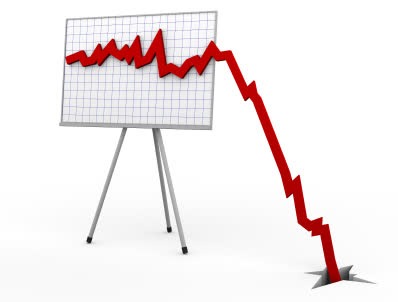Dividend Value Builder Newsletter
Altman Z-Score Formula – Screening For Bankruptcy Risk

The Altman Z-Score is a formula of 5 basic financial ratios to help determine the financial health of a company. In particular, it is a probabilistic model to screen for bankruptcy risk of a company.
As value investors, one of our most important rules is to avoid incurring large losses. There are two easy ways to subject yourself to possible large losses; buy stocks for more than they’re worth, and buy stocks of companies that go bankrupt.
If you buy an asset with an intrinsic value of $100 for $60; you have a large margin of safety. It is highly unlikely you will lose a lot of money on this purchase, unless, the company goes bankrupt. Sure it might fall to $50, or even $40, but it will most likely not approach zero unless the company is headed for bankruptcy.
I learned this lesson the hard way in 2000 when I bought Enron. No, I didn’t pay $80, or $60, or $30, or even $10. I was a value investor! I waited until it got down to $5! But does it really matter? I still lost 100% of my money on that investment. If I had used the Altman Z-Score, which was warning of an impending bankruptcy, I would have avoided a total loss.
The Altman Z-Score Formula
The original formula was created for publicly traded manufacturing companies.
Z-Score = 1.2(A) + 1.4(B) + 3.3(C) + 0.6(D) + 1.0(E)
Where:
A = Working Capital (Current Assets – Current Liabilities) / Total Assets (Measures liquidity of firm)
B= Retained Earnings / Total Assets (measures accumulated profits compared to assets)
C= Earnings Before Interest & Taxes (EBIT) / Total Assets (measures how much profit the firms assets are producing)
D= Market Value of Equity (Mkt. Cap. + Preferred Stock) / Total Liabilities (compares the company’s value versus it’s liabilities)
E= Sales / Total Assets (efficiency ratio – measures how much the company’s assets are producing in sales).
Z-Score Results:
Z-Score of < 1.81 represents a company in distress.
Z-Score between 1.81 and 2.99 represents the “caution” zone.
Z-Score of over 3.0 represents a company with a safe balance sheet.
The Altman Z-Score has become popular enough to be found in most data services such as Y-Charts.
Here is a Z-Score calculator for those who want to figure the calculation directly from company financials:
History of the Altman Z-Score
Edward Altman was a NYU Stern Finance Professor in 1968 when he developed the original Z-Score. Recently, he has produced updated versions for private companies, non-manufacturing companies, and emerging markets companies (see below).
For those interested in really delving into the subject, here is his 2000 Research Paper:
Predicting Financial Distress of Companies: Revisiting the Z-Score and Zeta Models
Z-Score Accuracy and Limitations
Studies show that the Z-Score is able to predict 80-90% of bankruptcies 1 year prior to the fact. It does this with a small percentage of false positives. In other words, the formula provides high confidence probabilities but not certainty.
Other studies show that there is great value in evaluating the strength of balance sheets. Stocks of companies with weak balance sheets underperform the market more often than not. This makes the Altman Z-Score a great tool to quickly screen the health of a balance sheet.
There are limitations which should be kept in mind. First the Z-Score does not work with private, financial, or foreign companies. Altman later developed revised versions:
Z1-Score – Score for Private Firms
Z1 = .72(A) + .84(B) + 3.107(C) + .42(D) + 1.0(E)
Where:
A = Working Capital (Current Assets – Current Liabilities) / Total Assets (Measures liquidity of firm)
B= Retained Earnings / Total Assets (measures accumulated profits compared to assets)
C= Earnings Before Interest & Taxes (EBIT) / Total Assets (measures how much profit the firm’s assets are producing)
D= Book Value of Equity / Total liabilities (substitutes BV instead of market value for private companies)
E= Sales / Total Assets (efficiency ratio – measures how much the companies assets are producing in sales).
Z-Score Results:
Z-Score of < 1.23 represents a company in distress.
Z-Score between 1.23 and 2.9 represents the “caution” zone.
Z-Score of over 2.9 represents a company with a safe balance sheet.
Z2 – Score For Non-Manufacturers & Emerging Markets
Z2 = 6.56(A) + 3.26(B) + 6.72(C) + 1.05(D)
Sales/Total Assets is left out of this formula since it is used for non-manufacturers.
Using Z-Score to Improve Your Investment Screening
The Altman Z-Score combines several important ratios into a single metric that provides valuable information about the financial health of a company. This makes the Z-Score a convenient and helpful formula as one of your first stock screens.
Backtests from Fat Pitch Financials indicates that the bottom 20% of company Z-scores do underperform the market. Otherwise the Z-score has little predictability for future returns. For instance, the middle quintile of scores outperformed the 1st & 2nd quintiles. In other words the usefulness of the Altman Z-Score is to identify the most vulnerable companies but is not a good overall predictive tool beyond avoiding the stocks of the weakest companies.
The importance of not losing all of your investment cannot be overstated. The Altman Z-Score will help you avoid companies that may be headed towards bankruptcy.
Additional Reading;
Intrinsic Value Stock Analysis – My Formula
Minimize Large Portfolio Drawdowns
Invest With Confidence in Less Time - Manage Your Portfolio Without Behavioral Errors
